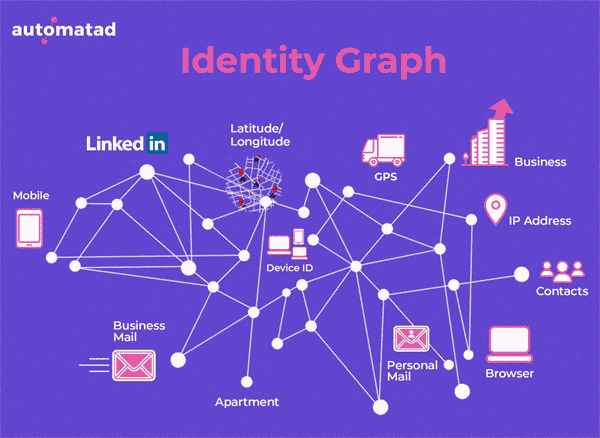Identity resolution has been a business need for years, but most recently rose as a key concept for digital publishers, due to the convergence of 3 factors:
- The growing number of devices used by each individual to connect to the net (4 and growing)
- The storage of key customer information in silos, such as email systems, web CMS, NPS surveys, and more.
- The death of the 3rd party cookies and a future of "cookieless targeting" while maintaining CPM rates.
Fortunately, identity resolution for digital publishers can provide unique, protected, visitor profiles and Unique IDs (UID) to enhance publisher revenue and visitor experience options.
Table of Contents:
- The Death of 3rd Party Cookies
- What is Identity Resolution?
- What is an Identity Graph?
- How Do Publishers Use Identity Data?
- Two Identity Resolution Models: Deterministic vs Probabilistic
- What are the Benefits of Identity Management?
- How Can Publishers Grow Visitor 1st Party Data Quickly?
The Death of 3rd Party Cookies
In the past, third-party cookies were vital to any publisher’s ad-connected strategy. Website creators, operators and curators can’t maintain digital real estate without resources, after all.
By and large, digital advertisements maintain the free-information status quo of the online world: Rather than charging users for information access, publishers can share content, products and services via ad revenue alone.
Because effective ads have been derived from comprehensive visitor behaviors across web properties, each snapshot’s relevancy is directly related to the data behind it. Third-party cookies can discern an audience’s likes, dislikes, preferences and general behavior—making targeting much easier.
This said, the consumers are demanding more data privacy, regulators are enforcing it, and the digital ecosystem is now in an industry-wide shift away from cookie-centric ad strategies, i.e. "cookieless targeting".
This has fueled the growth of identity resolution solutions, to replace 3rd party cookies with protected yet relevant targeting data to sustain ad value and CPMs.
What is Identity Resolution?
Identity resolution serves to create a holistic single view of the visitor by gaining information about device-to-device activity. Your visitors may arrive via desktop, but they might’ve first encountered your content via mobile, and this data may be kept in disparate silos. This cross-channel aspect opens up the opportunity for identity resolution —as a cost-effective and privacy-compliant method to better understand visitors.
What is an Identity Graph?
A database that collects and connects data on a single user profile. The data can surface in many distinct systems, such as email marketing lists, website visit data, survey responses, and more. This collection of data can be assigned a unique ID number, and used to inform all systems to ensure a consistent "single view of the customer".
Visual representation of the concept by Automatad:
How Do Publishers Use Identity Data?
The data collected from a cross-channel identity resolution strategy can be compiled into individual user profiles. These profiles, as info-packed glimpses into user habits, lifestyles and demographics, are often called ‘identifiers.’
An Internet user’s identifier can be boiled down to something as simple as a customer ID on your website—but it extends across loyalty program membership numbers, local business searches, common social media activity, and more.
Putting an abundance of data to good use is tough, of course: After compiling customer identifiers into comprehensive user IDs—each of which, often, being referred to as a ‘UID—publishers need to create strategies that remain flexible.
Each UID is expected to shift around, during its journey, of course. And this means that any flexible strategy isn’t only flexible in cross-channel data collection, but in its user communication sincerity.
Two Identity Resolution Models: Deterministic vs Probabilistic
To create effective strategies, of course, publishers must apply identity resolution resources effectively. To do so, they need to identify which platforms, devices and digital channels to target. They must also connect each user group to their respectively used devices—so as to understand the relevance of each.
Because identity resolution has a number of variables to consider, it’s best broken down into two main approaches—a deterministic approach, and a probabilistic approach.
What is Deterministic Identity Resolution?
In this approach to identity resolution, digital advertisers and publishers tally up information derived directly from first-party data. Things like mobile numbers, credit card numbers, and sign-in information are used, so as to utilize freely given, highly accurate information for better customer experiences.
What is Probabilistic Identity Resolution?
This approach to identity resolution tallies up a user group’s “ID points.” Anonymized identifiers, like OS information, browsing patterns, and Wi-Fi network information, help digital advertisers and publishers figure out which qualities users have in common—then create probability-based solutions.
What are the Benefits of Identity Management?
Today’s newest data analytics strategies are driven by everyday website visits, and even unconverted visitors can contribute important information. Identity resolution has more than a few benefits, but several are particularly valuable to publishers and digital advertisers:
- It helps branded website owners analyze unknown visitors.
- It helps establish a consistent user experience.
- Identity resolution can improve targeting/segmentation efforts which can drive higher CPMs
- Creates a more accurate customer data truth set for making key business decisions
How Can Publishers Grow Visitor 1st Party Data Quickly?
While identity resolution vendors bring together visitor data into a single view, they are limited by the publisher's ability to engage visitors to collect accurate and helpful data.
Admiral's Visitor Relationship Management (VRM) platform provides an automated engagement engine for site visitors.
Admiral VRM can serve as a registration wall for user authentication out of the box. But publishers can also use VRM to engage users for email signups, app downloads, social media follows, content subscriptions, adblock recovery, donation campaigns, and more.
You can even use Admiral to target specific user segments you want to understand better, such as adblock users, or visitors from EU. With the addition of AI and machine learning, Admiral's visitor data, targeting, and segmentation keeps getting better. See: AI Targeting on Traffic Surges and Content Popularity
Identity resolution, at the end of the day, is about one’s ability to reach visitors, inspire them, communicate with them and make their time more than worthwhile. Providers like Admiral dedicate themselves to helping publishers connect with visitors directly, with the right message at the right time.
By applying innovative, analytical and cutting-edge technologies to your strategy’s specific needs, we hold true to our most-valued ideology: Relationships Matter.
Whether you’re new to managing UID tools, identity resolution approaches or cookie-less strategies in general, we’re here to help. The death of 3rd party cookies shouldn’t be feared, and your strategy can become stronger than ever with a skilled provider at your side. Identify your brand’s customers on their terms, and in the way which matters the most: With them as your priority.
Request a demo of Admiral VRM today.





